Milan Cernohorsky
Introduction
I live in Prague, Czechoslovakia, which may seem to Americans who have not visited there, to be a city that might not have strong representation in the hi-fi arena. However, even though its history dates back a very, very long time, it is just as modern as any other city in the world, and perhaps more so than many. The city is a thousand years old, beginning with the Prazsky hrad (Prague Castle) which towers above the Vltava river. In 1993, Prague became the capital of the Czech Republic (the Federation was from 1918 to 1993). The current population is about 1.2 million. We get 80 million visitors each year, and if you have not seen it yet, you should.
Prague hosts many hi-fi brands. Following is a list of the products you can buy here:
|
AIWA TARGET AKG MediaTech ALESIS ALCHEMIST ALPINE ALR/JORDAN ARCAM AUDIO ALCHEMY AUDIO RESEARCH AUDIOLAB AUDIOMAT AUDIOQUEST AU/RA AUTHENTIC VOICE (Czech loudspeakers) B&W BANG & OLUFSEN BEDINI BLAUPUNKT BMG BOSE BURMESTER CABASSE CANON CAMBRIDGE AUDIO CARDAS CASTLE CEC CELESTION CERWIN-VEGA CESKY RECORDS CLARION CLASSE new CLEARAUDIO CYRUS DAEWOO ELECTRONICS DENON DESIGN ACOUSTIC (Czech loudspeakers) DEXON DP AUDIO (Czech amplifiers) EAGLE CABLE ELAC ELECTROCOMPANIET EMTEC MAGNETIC ENERGY EXPOLINEAR /loudspeakers FOCAL FOX AUDIO (Czech pre and power amplifiers) FUJI GENESIS
|
Golden Tube Audio GOLDRING GRADO GRAMOFON DUAL GRUNDIG GRYPHON HAMA / German cables, filters etc. / HARMAN KARDON HELIUS / German loudspeakers / INFINITY JADIS J.A.MICHEL ENGINEERING JAMO JBL JECKLIN FLOAT JM LAB JVC KENWOOD KIMBER CABLE KOSS LOEWE MAGNAT MAGNEPAN MARANTZ MARK LEVINSON MARTIN LOGAN MASCOM MB - QUART McCORMACK McINTOSH MERIDIAN MIRAGE new MONITOR MONITOR AUDIO MONITOR CABLE MONSTER CABLE MORDAUNT-SHORT MYRYAD NAD NEUMANN NOKIA ONKYO PANASONIC/TECHNICS PENTAGON
|
PERREAUX new PHILIPS PHOENIX GOLD PHONAR / German loudspeakers / PIONEER PLINIUS new PROCEED PROJECT PURIST AUDIO DESIGN QUAD REFERENCE RECORDINGS REGA REVOX RI � AUDIO (Czech pre and power amplifiers) ROKSAN ROTEL SABA THOMSON SAMSUNG SANYO SENCOR SENNHEISER SHAKTI SHAN (Czech loudspeakers) SHARP SHEFFIELD SHERWOOD SINUS LIVE / German cables / SME SONUS FABER SONY TANNOY TDK TEAC THETA DIGITALTHOMSON TOSHIBA ITO CS VAN DEN HULL VECTEUR VISATON VIVANCO VOGEL'SWADIA WARNER MUSIC XAVIAN (Czech loudspeakers) XLO YAMAHA
|
See what I mean? It is pretty much what you can find in any large city anywhere in the world. However, there are some very interesting products that originate here too, and I thought western readers of Secrets might like to hear about them. Discussed below is DPAudio. Later on, I will talk about AU/RA turntables (see photo below), Shan, Xavian (speaker shown in photo below), and RI-Audio. Following the DP Audio discussion, I will review a new Swiss speaker design that premiered in Prague, the Reference 3A Royal Master.
 |
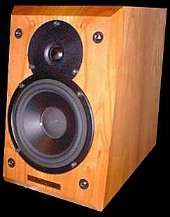 |
The best Czech design engineers and top quality Hi-Fi producers (a so-called Top Five) will be presented step by step. This group comprises well-established, well-known manufacturers, whose products both have won public attention and proved their quality in numerous non-biased, objective reviews.
I
dare assert, that products described in the first part could hands-down in
terms of quality and performance/price ratio succeed even in the hardest
competition in most prestigious
markets around the globe. No doubt that if any of these products had been a subject to a review in any foreign Hi-Fi magazine, the reviewer could
have done nothing but to issue a �strongly recommended� statement.
I
firmly stand behind my assertion that my opinion does not stem from
nationalism. The fact that so far, only a few of these products have been reviewed in
the foreign press cannot
be interpreted as their being of dubious
quality. To get your gear on, e.g., a German market, one needs to invest a lot of
money, and such immense investments still exceed the resources of most Czech manufacturers.
Some of the producers (other than here presented) found their own way
by sticking brilliant labels on their own gear, and
then the
public falsely presumes they have been manufactured elsewhere. I firmly
believe that you will be pleasantly amazed by what I show you here. And, I�m sure,
there is no need to stress this fact to domestic, experienced audiophiles.
This
little firm was founded in May, 1996 in Prague. Its main business is
development and production of high quality amplifiers under the Dudek
trademark. Pavel
Dudek
has lifelong experience in this field. His main focus is maximum sound
quality. They have a listening room to which you
can bring your own amplifiers for a comparison with theirs. Seven models are produced
now: Five types of power
amplifiers, one control amplifier, and passive control unit. The selection of
Dudek power amplifiers is further enhanced by two modified version labeled as SE.
The DPA386 and 386SE also have 100 watts x 2 into 4 Ohms, but use MOSFETs instead of bipolar transistors. The total power supply capacitance is 20,000 �F per channel. The DPA 383 is a 200 watt monoblock.
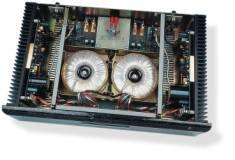
The DPA111/DPA 114 is a control amplifier (preamp) with a separate power supply, giving an excellent signal to noise ratio.
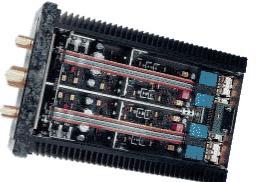
For
a passive
control unit, DP Audio offers the DPA 101. It does not contain any active
components. An ALPS potentiometer is used for volume control, and input and output
cinch connectors are gold plated.
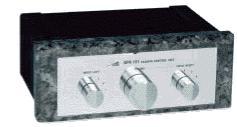
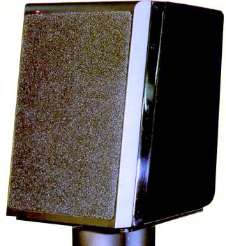
When
I was skimming through the materials about the Chicago Hi-Fi Show, I remember making a remark on
the highly acclaimed Reference 3A Royal Master II loudspeakers. I wished I
could get some so I could audition
this desirable piece of kit. But I felt it is hardly going to be available
here in our market. Fortunately, I was completely
wrong. Not only did we find that import was imminent, but we
were also granted a pair of these solitaires for the auditioning test
(courtesy of Hi-Fi Studio Pansky Dvur). Let�s have a look at how the very first pair of these speakers in the Czech Republic
fared.
This two-way bookshelf loudspeaker is pretty hefty. Although the manufacturer, a Switzerland based company Innovative Acoustic (Innovac), does not state its inner volume, the external proportions suggest a rough 20 liters. The pair together weighs 36 Kg. The label on the back shows the product serial number and specifications (maximum load of 100W, sensitivity of 92 dB). Above the specifications tag you can find the gold plated binding posts fitted for bi-wiring. Two pairs of short silver linking cables (Silteck) are also provided for conventional wiring. Siltech is also used for the inner interconnections. The back panel further contains an oval bass-reflex port, approximately 55 mm in width. Its length is unidentifiable as the tubed part of the bass-reflex is not straight. It resembles the trunk of an elephant, but curved downward. According to specifications, the attenuation at 44 Hz is at the -3 dB mark. The side walls of the shelf are finished in gloss piano black. The woofer and the tweeter are both covered with a black cloth grille, stretched untraditionally in a metal chassis, and it is attached to the front of the loudspeaker with a magnet. The front part of the shelf under the grille is made of a dark foamy material that covers the passive parts of both speakers and thus effectively helps to reduce unwanted diffraction. The textile dome tweeter has a diameter of 26 mm and was apparently manufactured by Eton. The crossover contains special a Musicap capacitor which assures a smooth decline of the characteristics from 3 kHz upwards (-3dB, then 6 dB per octave) and proper impedance corrections. The 21 cm carbon fiber woofer with a special phase corrector is directly connected to the speaker terminals. It�s a non-standard series, not likely to be encountered on the free market. The phase characteristics are nearly celestial.
The outward appearance gives a feeling of rock solidity, rigidity, and resistance, attributes found in professional monitors, rather than in loudspeakers destined for home listening. The design of these loudspeakers is extremely rational, void of any superfluous parts. Its beauty lies in its simplicity. Tapping on the shelves gives a feeling as if the speaker was carved out of rock.
Sound
We
started our test by feeding the speakers with various coherent and multi-tone test signals. The mechanical parts at
any given frequency did not produce even the slightest hint of
resonance. No peaks or drops in the frequency spectrum were
registered. The woofers audibly reproduced signals slightly below 30 Hz. I was
impressed by the characteristics of the
low frequency regions (i.e., the usual bass reflex wave was almost
indiscernible).
Imaging
is a problem for consumer speakers. But, I was particularly
impressed by the problem-free transition between different frequency regions
in this speaker. Even costly loudspeakers
may introduce some deteriorating artifacts around the crossover frequency. For
instance, a clarinet playing various tones of a musical scale can be perceived
as two separate instruments. This was not the case with the Royal Master II. Their amazingly clean presentation of various frequency
regions reminded me of electrostatic designs. These musical attributes were
further supported by the already mentioned smooth frequency decline of the
crossover. The musical instruments were reproduced very realistically and
without any artifacts, even in the lowest frequency regions. The bass was
absolutely tight and full-bodied. This was especially noticeable in orchestral
pieces, where the ambience characteristics of orchestral music were perfectly
rendered.
Associated
equipment included a Denon DCD3000 CD Player connected with DP Audio Sound
Refiner Cables to the DP Audio 386SEII Power Amplifier. We alternated between
Leedh and KrautWire 3 Czech-made speaker cables.
This is my long preferred chain of ancillaries, and nothing has yet made
me want to change them. On the contrary, the listening session confirmed that claims
of coldness in presentation with DPAudio amplifiers were just a chimera that immediately fizzled out when
listening to the Reference 3A.
A
reviewer's phrase, "They tend to disappear from the listening room� here
means, "It�s as if they did not exist.� In other words, the sound was
transparent. The entire musical scene was laid back
to the space beyond the speakers. This indicates that the Reference 3As are
clean, without brightness, and that they can offer tireless listening experience
over extended periods of time. The middle frequencies around the crossover
frequency region were not altered. Instruments playing in only one channel didn�t tend to be
isolated in the speaker, and the natural bounce
and dynamics of the music were well preserved. The mids could only be
described as full-bodied and rich, though not present or even diverting
attention from the whole. The highs were similarly brilliant, smooth and
clean. Instead of monitoring the sound, the Reference 3As let the music flow,
but without losing detail. To my great surprise, I was able to
consume an
entire heap of classical music tracks. During
the 4 hour listening session I was just switching between different CDs
(Brahms,
Bach, Grieg, Haydn, Puccini), without succumbing to the switch-over
neurosis. The Royal Master II similarly excelled in less demanding genres. No
matter whether I listened to guitar music, hard-rock, or heavy metal, they
were always precise. I never felt any loss of detail or dynamics in
the frequency extremes. In this respect, the Reference 3As reached the two-way speaker
Olympus (nirvana).
After
first fifteen minutes of listening, I had the impression that I had never
before
listened to such a good sounding bookshelf, and I still have this impression
now. It seems that these speakers have set a new reference level for me.
Though their construction philosophy is different from e.g. the Dynaudio Contour
and Confidence (simple crossover design versus complicated and high sensitivity
versus low, the material and the woofer solution applied), the Royal Master II
presentation of music strongly resembled these Denmark designs in neutrality
and the vanishing effect. What�s
more, no bass tuning and no special attention to positioning are required, at
least in my listening environment.
Conclusion
The Royal Master II, though a two-way bookshelf design, has a full-bodied. They belong in a category where critical words are difficult to find. They reproduce music with perfect control and reserve. The listener�s affection or dislike for how the speaker affects the color of a reproduced instrument is directly reliant on the listener�s personal preference. Looking at the Reference 3As in this sense, they will represent an attractive choice for a wide range of listeners. They reproduce sound very realistically and naturally, no matter what the genre. They could be described as an all-rounder. But the most surprising to me is the exquisite bass reproduction that is simply flawless. The bass is dynamic and thick, but remains clean and easily discernible at the same time. I would mainly recommend them to listeners preferring classical music and searching for a no-compromise solution in a listening room of 20-50 square meters. In my opinion, it�s a splendid product filling one of the many gaps on the Czech Hi-Fi market, but also in any audiophile's home anywhere in the world.
I believe that for a genuine music lover these speakers represent a good, long-time investment. They allow the consumer to fully enjoy the less frail values of our frantic life.
Specifications:
MFR:
40 Hz - 20 kHz � 3 dB
Suggested
Power: 100
Watt
Nominal Impedance: 8 Ohms
Sensitivity: 92 dB/W/M (a good sensitivity for low powered tube amplifiers)
Distortion: 0.3% at 92 dB and 1 kHz
Weight: 18 kg each
Size: 400mm x 330mm x 320mm
MSRP
(USA):
North American Distributor:
Divergent Technologies, Inc.
21 St. Leger Street
Kitchener, Ontario, CANADA N2H 4L8
Phone 519-749-1565
Fax 519-749-2863
Web http://www.reference3a.com
E-Mail [email protected]
Return to Table of Contents for this Issue.

